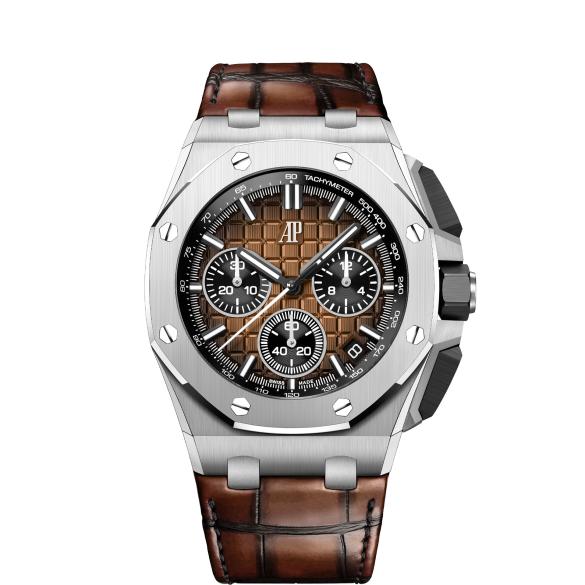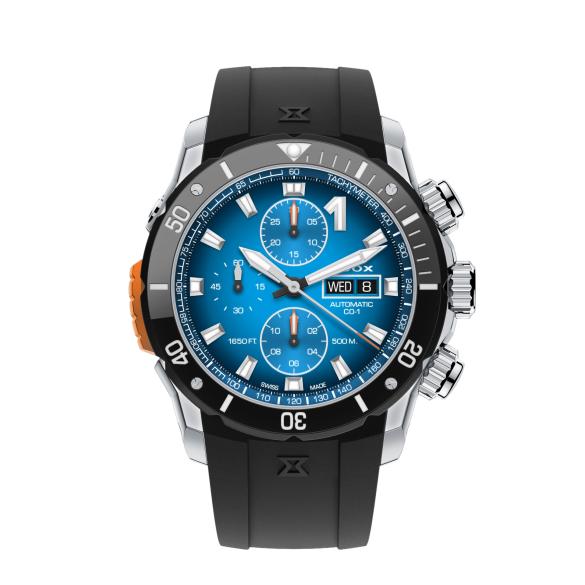TAG Heuer brings a Formula 1 inspired smart watch with the TAG Heuer Connected Calibre E4 45MM x Oracle Red Bull Racing Edition
Chronograph
A chronograph is a timing mechanism to show elapsed times. It acts as a stopwatch and can have more additional functions. A basic one has an independent sweep seconds hand and starts, stops, and returns to zero by using buttons or pushers. More complicated ones use additional complications and can have multiple independent hands to measure seconds, minutes, hours, and even 1/10th or 1/100th of a second.
.
Most modern chronographs also feature totalizers or counters shown simultaneously as the recorded time is progressing. The most common ones are a minute counter, mostly counting to 30 minutes only, and an hour counter, counting up to 12 hours. And the most popular chronograph movement for a watch, so far, is the ETA/Valjoux caliber 7750 which has its roots in the Venus caliber 188 from 1948.
.
The word “chronograph” comes from the Greek words chronos (meaning “time”) and grapho (meaning “to write”), originally referring to early devices that recorded time by making marks on paper.
.
Who invented the chronograph?
.
It is believed that in 1816 Louis Moinet (1768–1853) invented the chronograph as he wanted to track astronomical objects and observe celestial events. After serious research by the brand Louis Moinet, which was not founded by Louis Moinet but by smart businessmen using his name (legally), on March 21, 2013, the International Watch Museum in La Chaux-de-Fonds, Switzerland, recognized Moinet’s invention. So, since then, Moinet has been credited with creating the first chronograph.
.
His device was called “compteur de tierces”, French for “third counter”, and all Moinet’s personal records and timepieces were examined to conclude that another chronograph-like mechanical device was not the first chronograph. Moinet’s chronograph is described as a device capable of measuring fractions of a second, up to 1/60th of a second, and the revelation was made public at the Neuchâtel Observatory, an important Swiss institute that was famous for its chronometer trials. Organizations like a watch museum and observatory always help to strengthen a claim. However, it raises a few questions of course, which always happens with new “claims” like this.
.
Another chronograph inventor
.
Before the Moinet research, Nicolas Mathieu Rieussec (1781–1866) was credited for inventing the chronograph. Basically, since he patented his device in 1821 already. He created a time-recording instrument that marked ink on a rotating dial that allowed event timings to be easily read and recorded. It was used by King Louis XVIII of France to time horse races for instance.
.
It is unclear if and how and when Rieussec’s personal records and timepieces were researched. Sure, his patent was later than the year coming from the results of the Moinet research. But maybe Rieussec invented his device way earlier before making it public. In a time people were inventing things at lightspeed and thus wanted to patent their inventions as fast as possible to prevent another person from claiming the invention, it is likely that Rieussec did not wait for years to patent his chronograph. But haven’t seen any evidence of that.
.
“Precursors”
.
Another thing. In 1725, George Graham developed an observatory timer with a weighted pendulum that could be stopped and started at will. It was ready in 1730. This stop-and-start mechanism was crucial because it enabled astronomers to precisely measure time intervals between celestial events. The ability to stop and start the pendulum without affecting its timekeeping was revolutionary for accurate observations of stars, planets, and other astronomical phenomena.
.
So, this was a stopwatch, it could measure intervals of 1/16th of a second, and it was big. It was a stationary, pendulum-based clock, but it does not exist anymore. Fact is, it was far from portable. If one of the “rules” for something being a “chronograph” is that it should be portable, Graham’s invention doesn’t count. However, the meaning of “chronograph” is “writing time”, not “writing time and carrying it”. Louis Moinet’s Compteur de tierces is a pocket watch. Rieussec’s device is a wooden box with a mechanism inside. But hang on…
.
Is John Ellicott the inventor of the chronograph?
.
John Ellicott (1706-1772) is a highly skilled clockmaker and watchmaker in the London horological scene during the 18th century. He is known for designing public clocks, for inventing a compensated pendulum in 1752, and he adopts the cylinder escapement invented by George Graham, making it more popular. And, he also created a pocket watch with a stop-second system.
.
Just take a look at this pocket stopwatch, made by John Ellicott’s son, also named John Ellicott (1733-1807). It is a center-seconds stop-watch movement with a cylinder escapement. The museum dates it between 1790 and 1810. It is portable, however, people say it does not “write the time”. Moinet’s chronograph has sub dials to “count” and “write” the elapsed time.
.
But Ellicott’s watch could also count time, only in seconds. With a central hand, and indicated by a seconds track at the flange of the dial. You could say it’s a watch with running seconds, like a regular modern three-hander with stop-seconds device by pulling the crown. You can also say that during the time it was invented it could track elapsed time. And no, it could not be reset to zero. So, this could be a valid argument for not calling it a chronograph. And writing time needs some calculation with a static seconds track on the flange without being able to go back to zero whenever you want. However, you can wait until the seconds hand passes zero again.
.
Anyway, it is all about definition, and being “the first” is not only historically significant, but it certainly has some commercial benefits too.
.
Modern chronographs
.
In the mid-1800s chronographs slowly became more popular and they were often used for military purposes; timing artillery fire. Nowadays they involve the timing of sports games, piloting airplanes, car racing, diving, and submarine maneuvering.
.
For watches, there are several types:
.
- Cam-actuated chronograph: Affordable, simple mechanism, less smooth
- Column-wheel chronograph: Higher-end, smoother, more refined
- Flyback chronograph: Allows instant restart, useful for rapid resets
- Rattrapante chronograph: For split-second timing, very complex
- Mono-pusher chronograph: Minimalist, vintage style, single-button operation
.
Watches with a chronograph
For all Indy 500 fans there is this TAG Heuer Formula 1 Chronograph x Indy 500 as it has some references to this legendary car race
There is more steel than gold on the new Longines Spirit Flyback Steel/Gold, a cool vintage styled chronograph with a diameter of 42 millimeters
The Jacob & Co. Epic X Chrono 47 mm Carbon Forged Poker is a new addition to the 47-millimeter chronograph collection of JC
Blancpain Fifty Fathoms Bathyscaphe Chronographe Flyback Full Gold
The gold chronograph version of the Fifty Fathoms is the Blancpain Fifty Fathoms Bathyscaphe Chronographe Flyback Full Gold
Another collaboration from Hodinkee, this time leading to the TAG Heuer Carrera Chronograph Seafarer × Hodinkee to read tides
Audemars Piguet Royal Oak Offshore Selfwinding Chronograph 43 mm Smoked Bronze
A Royal Oak with a cigar inspired color is the Audemars Piguet Royal Oak Offshore Selfwinding Chronograph 43 mm Smoked Bronze
Grand Seiko Sport SBGC275 Caliber 9R 20th Anniversary Limited Edition
The Grand Seiko Sport SBGC275 Caliber 9R 20th Anniversary Limited Edition celebrates the use of the mechanical quartz-sauced movement
Four new models for the Edox CO-1 Chronograph Automatic Bezel Lock, a huge tool watch with serious under water capabilities
A big chronograph that can seriously withstand water, this is the Certina DS Action Diver Chrono. So, a perfect timing device for water sports









